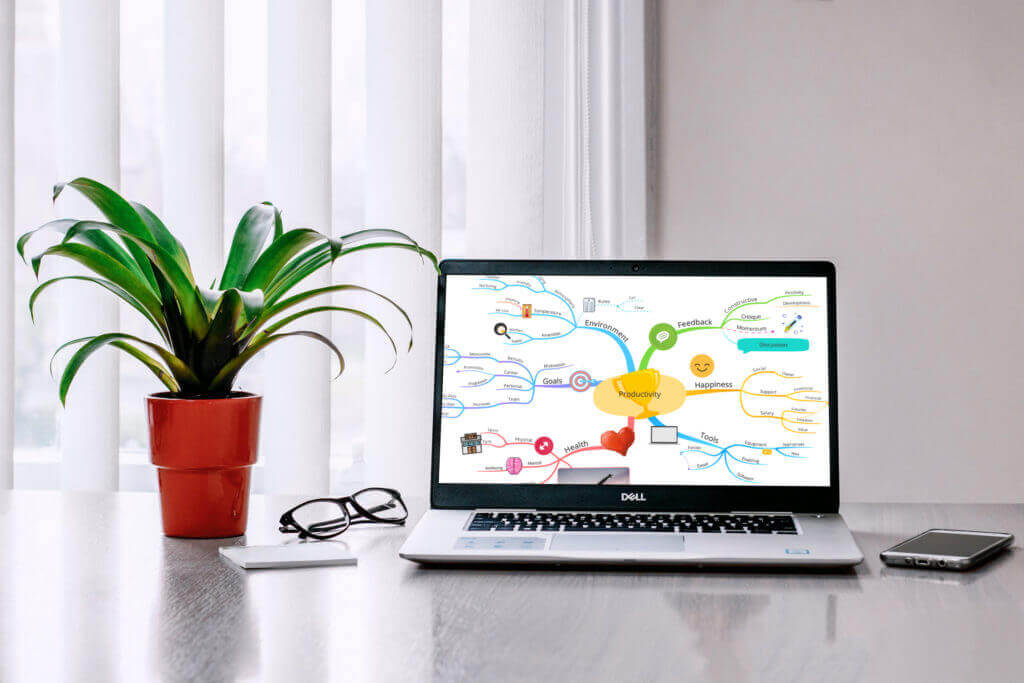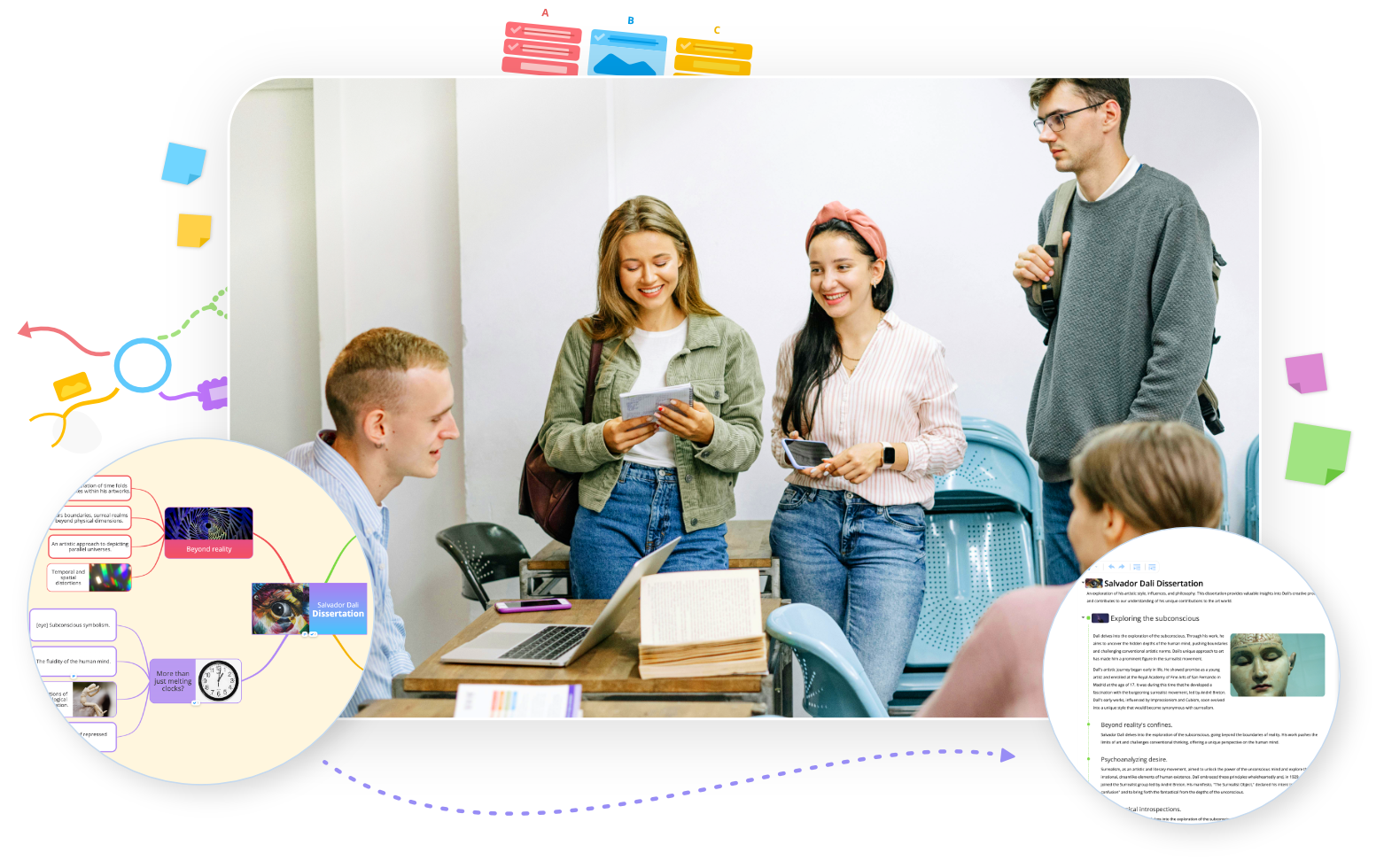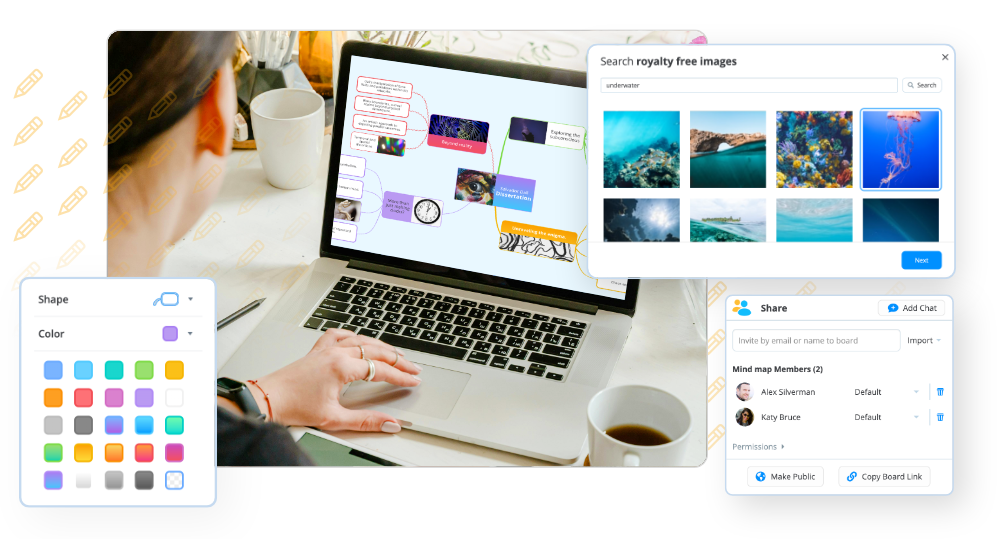Mind mapping is an effective creative thinking tool loved by over 250 million people around the world – and it’s something that most of us are familiar with (whether we initially realize it or not). Whether you called it a ‘brainstorm’ or a ‘spider diagram’, chances are you’ve used mind maps throughout your education and working life to brainstorm ideas for a presentation, structure an essay or report, plan a meeting, or even revise for an important exam.
One of the earliest documented examples of mind mapping can be traced back to philosopher Porphyry of Tyros in the 3rd century BCE, who used it to organize the works of the great thinker, Aristotle. Mind maps have remained popular to this very day (with Al Gore and Bill Gates being fans of the technique), and this is due to the fact that they are proven to boost our productivity, creativity and memory.
“So, what is mind mapping and how does it work exactly? Can’t I just stick to my lists and my conventional tried and tested techniques?” you ask? With many people being visual thinkers, mind maps can bring them countless benefits that you won’t get from a simple list.
Radiant thinking: mind maps explained
In its simplest form, a mind map is a collection of ideas that have been put into the format of a visual diagram. Starting with a central idea or topic in the middle of the map, branches radiate from the center containing further themes and concepts to be explored – typically in the form of words, short phrases, and images. This gives mind maps a natural organizational structure.
In a mind map, information is structured in a way that mirrors exactly how the brain functions – in a radiant rather than linear manner. It literally ‘maps’ out your thoughts, using associations, connections, and triggers to stimulate further ideas. They make it easier to extract your ideas from your head into something visible and structured.
Research shows that the brain likes to work on the basis of association, and it will connect every idea, memory or piece of information to tens, hundreds and even thousands of other ideas and concepts. This is why mind maps are beneficial for countless tasks.
Below, we will critically discuss how you can use mind maps to aid in various processes, such as memorizing information, conducting presentations and solving problems.
Memory
Mind maps involve a unique combination of imagery, color and visual-spatial arrangement which is proven to significantly improve recall when compared to conventional methods of note-taking and learning by rote. Ayoa’s mind mapping tool is faithful to these beneficial features, giving you the option to create quick box-style or highly creative maps with adjustable curvilinear branches, as well as add images and emojis, and change the color of your branches and text.
Don’t just take our word for it – countless studies prove that this creative thinking technique is a highly effective tool for improving memory. Some of these are outlined below:
- A study by Farrand, Hussain, and Hennessey (2002)1 found that mind mapping improved the long-term memory of factual information in medical students by 10%. They reported that “mind maps provide an effective study technique when applied to written material” and that they are likely to “encourage a deeper level of processing” for better memory formation.
- Research by Toi (2009)2 shows that mind mapping can help children recall words more effectively than using lists, with improvements in memory of up to 32%.
- Glass and Holyoak (1986)3 found that by gathering and highlighting key branches within a boundary, such as a highlight cloud, you’re using a memory technique known as ‘chunking’. Our short-term memory is on average only capable of storing seven items of information and chunking can help us use this storage space more effectively.
Creativity
Mind maps really come into their own when it comes to encouraging creativity and enabling you to generate new ideas in brainstorming sessions. This is because the spatial layout of a mind map helps you gain a better overview, making new connections more visible so you can create an infinite number of thoughts, ideas, links, and associations on any topic. Adding images to a map can also aid in this process by acting as visual stimuli. Images are processed instantly by the brain, enabling us to quickly make associations and recall information.
- A study by Al-Jarf (2009)4 proves that mind mapping software (such as Ayoa) offers a powerful approach for students to improve their ability to generate, visualize and organize ideas. The students involved in the study reported that the mind mapping tool encouraged creative thinking and they became faster at generating and organizing ideas for their writing.
- According to Margulies (1991)5 before children learn a language, they visualize pictures in their minds which are linked to concepts. Unfortunately, once children are trained to write only words in one color, on lined paper, their creative channels and mental flexibility diminishes. Using images, like you would in mind maps, keeps this creativity fired up.
Learning
Mind maps are a great aid in learning for countless reasons. Because they encourage the brain to make associations between different keywords, phrases and images, they can be used by students to brainstorm ideas for creative projects (either alone or within a group), as well as help them to plan and structure work such as essays, reports and presentations. Mind maps are also a great revision aid due to the fact that they can be used to break down complex information and improve memorization and recall.
- Goodnough and Woods (2002)6 discovered that students perceived using the technique as a fun, interesting and motivating approach to learning. Several students attributed the fun aspect to the opportunity to be creative when creating maps through a variety of choices in color, symbols, keywords, and design.
- Mind mapping has been shown to bring a renewed sense of enthusiasm to the classroom because it increases student confidence and sense of skill in mastering assigned materials (Mento et al, 1999)7.
Teaching
As a pedagogical (learning) tool, the visibility of mind mapping provides an effective approach to promoting better understanding in students. The flexibility of this tool means that it possesses several uses in the classroom, such as for teachers explaining work to students in lessons, and devising future lesson plans and revision guides. Using mind mapping software in the classroom is also a successful way to support children’s exploration and presentation of ideas.
In a study, Ralston and Cook (2007)8 found that an exercise involving mind mapping software provided a useful focus for pupils to organize their thoughts and to present information clearly and attractively. It also facilitated communication between pupils.
Ayoa’s mind mapping tools are flexible and easy to use, making them a great aid for educators and students at all levels. A teacher from Ysgol Gyfun Bro Morgannwg School in Wales in the UK has noted that: “[Mind mapping in] iMindMap [now Ayoa] facilitates teachers when explaining work as they can pictorially represent a lesson plan, while for students it encourages freedom of expression when planning their work.”
Planning and organization
Evidence shows that mind mapping can be used to help you plan and organize your thinking before you start writing or get stuck into a project. This is because you can use the technique to develop all your ideas and see where they relate to each other before deciding the best way to go about the task at hand.
A study by Holland et al (2003/2004)9 found mind mapping to be a useful technique for helping students to plan their essays and projects more effectively. By using mind maps, students were able to improve the overall structure, coherence and, consequently, the quality of their written work, and they were able to draw value from the technique for project managing practical work.
Presenting
How does mind mapping work for improving presentation skills? In a study, Mento et al (1999)10 discovered that executive students using only mind maps for presentations were able to handle challenging questions with confidence. This is due to the fact that the students could internalize the information more effectively because of the mind map’s unique representation of it. Thus, they had better recall of the information they needed because it had been captured and stored in an integrated, radiating manner rather than a linear one.
In addition to this, a study by The Wharton School (1981)11 had previously proved the benefits of utilizing visual elements in presentations and tightly integrating them with words. Presenters who used visual language were perceived by the audience as being more effective than those that did not. Not only were these presenters said to be clearer and more concise, but they also appeared to be more concise, interesting, professional and credible to boot.
A mind map is an excellent tool for collaborating with others to develop plans or implement key projects. It allows you to harness the input of all members of a group in a dynamic and creative way, so all ideas or statements can be recorded in an appropriate place within the mind map and discussed openly at a sensible time.
Zampetakis et al (2007)12 found that students preferred to work with mind maps in teams. This allowed them to develop synergistic interaction, assemble collective knowledge and work with a group minded attitude. The flow of communications between group members also contributed to the creative process.
Ayoa makes it extremely easy to collaborate with your team, giving you the ability to share your mind maps with others with view-only or editing permissions. Users can also vote for their favorite ideas within a map, and the branches of your mind map can also be turned into tasks which can then be delegated to other users with Due Dates assigned.
Problem-solving
A mind map can help you think with greater clarity to explore relationships between ideas and the different elements of an argument, as well as generate solutions to problems. It puts a new perspective on things by allowing you to see all the relevant issues and analyze choices in light of the big picture. It also makes it easier to integrate new knowledge and organize information logically as you’re not tied to a rigid structure.
Mueller et al (2002)13 have discovered how the use of mind maps to plan patient care at Front Range Community College has resulted in enhanced thinking skills including critical thinking, whole-brain thinking, and comprehensive thinking. The strategy promoted holistic care planning by focusing on the patient as the center of the care plan and by enabling interconnections to be made between related nursing diagnoses and patient care data.
Additionally, mind mapping brings together your ‘left brain’ (which is thought to be associated with words, logic, numbers and linearity) and your ‘right brain’ skills (which are associated with curves, color, rhythm, images and space), making your brain’s performance more synergetic. This means that each cortical skill enhances the performance of other areas so that the brain is working at its optimum level.
How to harness the benefits mind mapping
Although mind maps are conventionally drawn by hand, using software can make the process faster and easier than ever. With mind mapping in Ayoa, you can create a map in minutes and easily share it with others so they can review your work, or even add their own comments and suggestions. With Ayoa being available on various devices (including iOS and Android), and mind maps being able to be exported into PDFs, you can also access your creations wherever you are.
Harnessing this technique (which has been scientifically researched and documented) has culminated in a software tool that is truly effective in increasing our thinking abilities, enhancing creativity and improving memory. Ayoa also goes one step further than other mind mapping software available on the market by offering highly effective Task Management capabilities and an Instant Messaging function all in one app.
Ayoa can enhance a whole array of activities, including organizing, creating, innovating, planning, presenting, note-taking, learning, structuring, communicating, problem-solving and project managing. Find out more about Ayoa’s features or get started for free today.
Want more advice on mind mapping? Check out our guide on how to mind map.
References
1. Anokhin P.K. (1973), The forming of natural and artificial intelligence. Impact of Science in Society, Vol. XXIII 3.
2. Farrand, P., Hussain, F. and Hennessy E. (2002), The efficacy of the ‘mind map’ study technique. Medical Education, Vol. 36 (5), pp 426-431.
3. Toi, H (2009), Research on how Mind Map improves Memory. Paper presented at the International Conference on Thinking, Kuala Lumpur, 22nd to 26th June 2009.
4. Glass, A.L. and Holyoak, K.J. (1986), Cognition. New York: Random House.
5. Al-Jarf, R. (2009), Enhancing Freshman students’ Writing Skills with a Mind Mapping software. Paper presented at the 5th International Scientific Conference, eLearning and Software for 6. Education, Bucharest, April 2009.
Margulies, S. (1991), Mapping Inner Space: Learning and Teaching Mind Mapping. Zephyr, Tucson, AZ.
Goodnough, K. and Woods, R. (2002), Student and Teacher Perceptions of Mind Mapping: A Middle School Case Study Paper presented at the Annual Meeting of American Educational Research Association, New Orleans, 1st to 5th April 2002.
Mento, A. J., Martinelli, P. and Jones R. M. (1999), Mind Mapping in Executive Education: Applications and Outcomes. The Journal of Management Development, Vol. 18, Issue 4.
Ralston, J. and Cook, D. (2007), Collaboration, ICT and Mind Mapping. Reflecting Education, Vol. 3, No. 1, pp 61-73.
Holland, B., Holland, L. and Davies, J. (2003/2004), An investigation into the concept of Mind Mapping and the use of Mind Mapping software to support and improve student academic performance. Learning and Teaching Projects 2003/2004, pp 89-94.
The Wharton School (1981), A Study of the Effects of the Use of Overhead Transparencies on Business Meetings.Wharton Applied Research Center, The Wharton School, University of Pennsylvania.
Zampetakis, L. A., Tsironis, L. and Moustakis, V. (2007), Creativity Development in Engineering Education: The Case of Mind Mapping. Journal of Management Development, Vol. 26, No. 4, pp 370-380.
Mueller, A., Johnston, M. and Bligh, D. (2002), Joining Mind Mapping and Care Planning to Enhance Student Critical Thinking and Achieve Holistic Nursing Care. Nursing Diagnosis, 13, 1, pg. 24.


